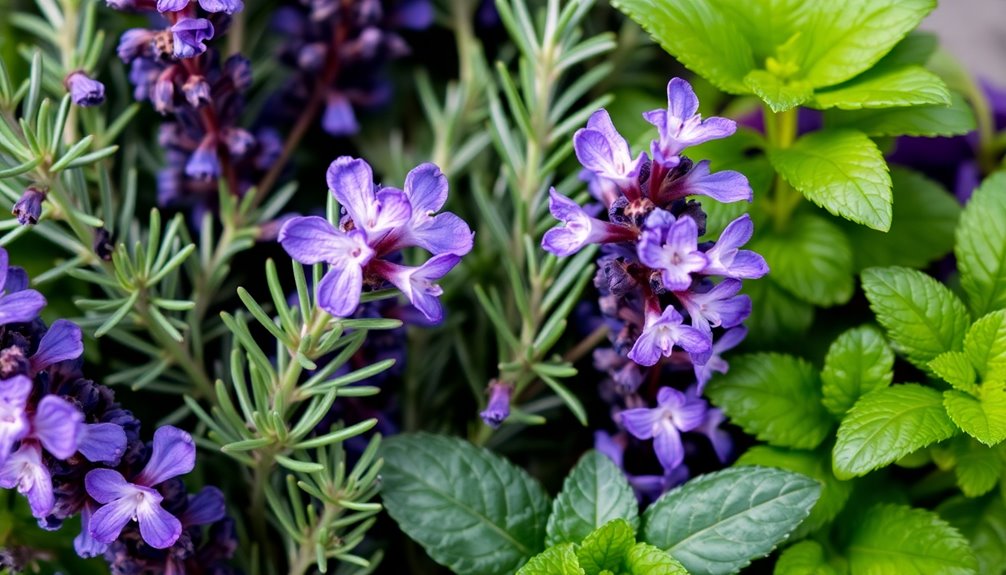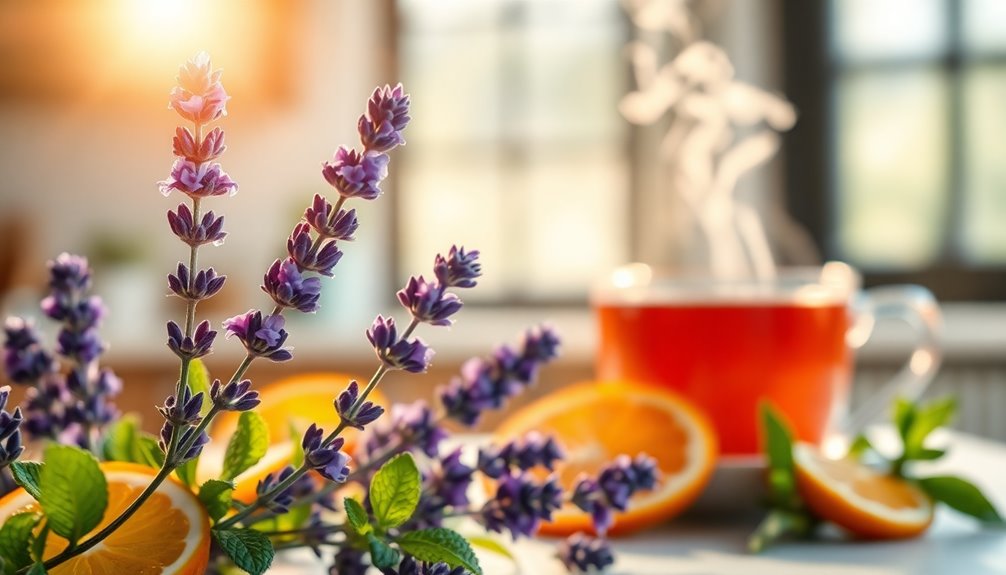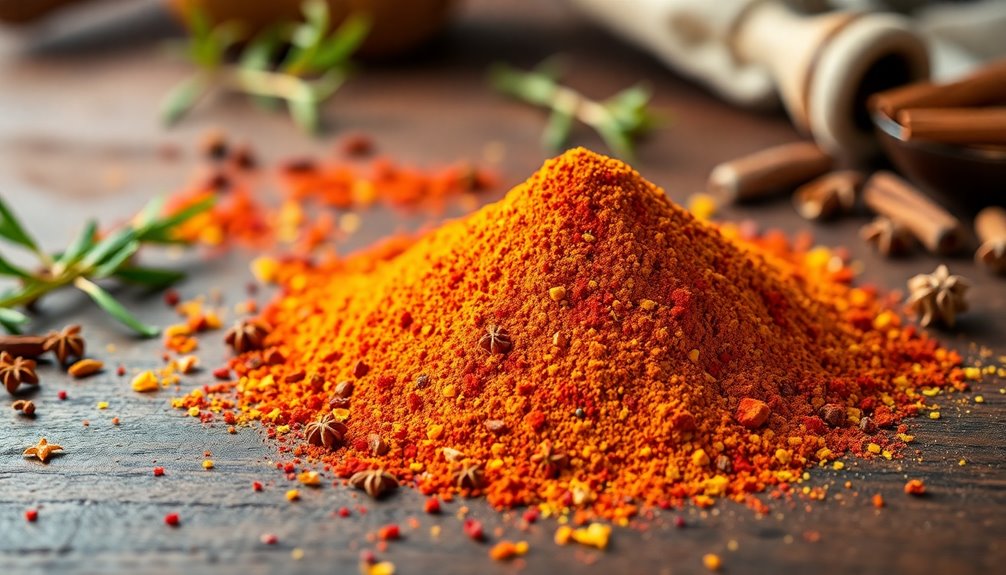Aromatic plants are nature's fragrant treasures that enhance your life in many ways. They produce essential oils that release delightful scents, making them popular in cooking, gardening, and aromatherapy. You might know them as culinary staples like basil, rosemary, and mint, but their benefits go beyond flavor. These plants can deter pests and attract beneficial insects, boosting your garden's health. Plus, they have therapeutic qualities that can reduce stress and promote relaxation. If you're curious about more aromatic plants and their diverse applications, you'll find plenty of intriguing information ahead.
Key Takeaways
- Aromatic plants produce essential oils that emit delightful scents, enhancing culinary dishes and therapeutic practices.
- They are resilient and adaptable, thriving in various growing conditions and contributing to perfumes and cosmetics.
- Common examples include lavender, rosemary, mint, sage, and basil, each offering unique aromas and flavors.
- Aromatic plants provide health benefits, such as stress reduction through aromatherapy and enhancing memory and mental clarity.
- Their pest-repelling qualities and ability to attract pollinators support healthier ecosystems and promote biodiversity in gardening.
Overview of Aromatic Plants

Aromatic plants are fascinating not only because they produce essential oils that release delightful scents, but also because these scents play a significant role in various aspects of our lives.
When you encounter aromatic plants like rosemary or lavender, you're experiencing their ability to enhance culinary dishes, improve therapeutic practices, and elevate sensory experiences.
With the human nose capable of detecting about 1 trillion scents, these plants become crucial in crafting perfumes and personal care products.
Additionally, many aromatic plants naturally deter pests, protecting gardens from browsing animals.
Economically, their importance is evident, as the global market for herbal supplements and essential oils is booming.
For many in developing countries, aromatic plants also serve as essential sources for traditional medicine. Moreover, the use of essential oils in aromatherapy has been shown to promote relaxation and reduce anxiety symptoms.
Key Characteristics

Essential oils are the defining feature of aromatic plants, released upon contact to create their distinctive scents. These plants exhibit several key characteristics that enhance their appeal and functionality.
- A strong aroma that can deter herbivores like deer and rabbits
- Culinary herbs like rosemary and lavender, known for flavor enhancement
- Resilience and adaptability to various growing conditions
- Essential role in the production of perfumes and cosmetics
- Rich aromatic qualities that elevate sensory experiences
You'll find that the aromatic qualities of these plants make them invaluable in both gardens and kitchens.
Their unique scents not only enrich culinary dishes but also contribute to both personal care and household products, proving their versatility and significance.
Popular Aromatic Plants
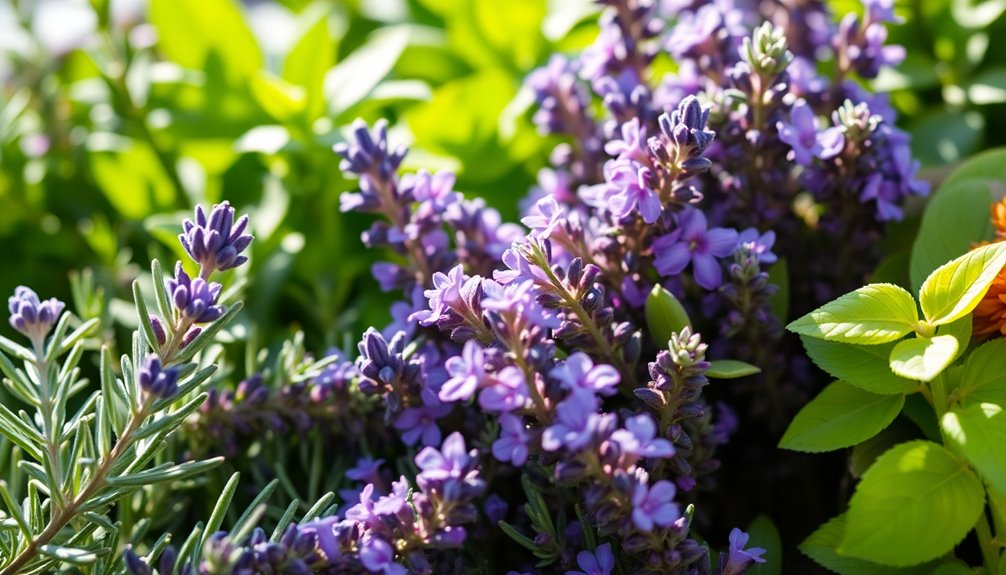
When you explore the world of popular aromatic plants, you'll discover a diverse range of options that not only enhance your garden but also elevate your culinary experiences.
Lavender is renowned for its sweet floral fragrance and is perfect for soaps and calming aromatherapy.
Rosemary brings a strong flavor and a potent aroma when you crush its leaves, making it a garden favorite.
Mint varieties, like spearmint and peppermint, offer an invigorating scent for teas and personal care products.
Sage's aromatic leaves produce a sweet herbal scent when touched, adding depth to your dishes and remedies.
Finally, basil's fragrant leaves are essential in various cuisines, enriching your meals with their rich, aromatic profile.
Aromatic Plants in Cooking

Aromatic plants play an essential role in cooking by enhancing the flavor of your dishes, from salads to meats.
You'll find that using fresh herbs like rosemary and basil not only elevates taste but also adds health benefits.
Let's explore some popular culinary herbs and effective techniques to make the most of these flavor-packed ingredients.
Flavor Enhancement Techniques
Flavor enhancement techniques play a vital role in elevating your culinary creations, particularly when you incorporate aromatic herbs like basil, thyme, and rosemary.
These herbs not only add depth but also freshen up your dishes. To maximize their flavor enhancement, consider these tips:
- Drizzle infused aromatic oils, like garlic & thyme, over pasta.
- Toss freshly chopped herbs into salads just before serving.
- Freeze leftover herbs in ice cube trays for quick access.
- Store herbs in the fridge wrapped in a damp paper towel.
- Harvest your herbs in the dry mornings for peak freshness.
Health Benefits Overview
Incorporating aromatic plants into your cooking not only enhances taste but also offers numerous health benefits. Fresh aromatic herbs, like thyme and rosemary, don't just make salads, soups, and pastas more flavorful; they also contain antioxidants and beneficial compounds that support overall health. For instance, turmeric's anti-inflammatory properties can also be harnessed in cooking to promote better health. Additionally, many aromatic herbs are rich in vitamins and minerals that further contribute to a balanced diet.
To get the most out of these herbs, use them immediately after chopping or slicing. If you have leftovers, you can freeze them to preserve their flavor and nutritional qualities for future use.
Additionally, consider making infused oils with aromatic herbs to elevate your everyday dishes while reaping their health benefits. By adding these vibrant plants to your meals, you're not just pleasing your palate but promoting your well-being too. Using infused oils can also provide benefits such as essential oils for dental health, which may help alleviate discomfort in your mouth.
Popular Culinary Herbs
When you think about enhancing your cooking, popular culinary herbs like rosemary, thyme, and basil immediately come to mind.
These fragrant and aromatic herbs can transform your dishes, making them more delicious and enticing. Here are a few favorites you might want to try:
- Rosemary sprinkled over roasted meats
- Fresh basil in a vibrant tomato sauce
- Thyme infused in savory vegetable medleys
- Mint for invigorating beverages and desserts
- Dill added to creamy dips and dressings
Using fresh herbs right after cutting preserves their vibrant oils and flavors. You can also freeze leftovers for later use.
Infused oils, like garlic and thyme, elevate your everyday dishes, offering convenience and rich flavors that make cooking even more enjoyable.
Therapeutic Benefits
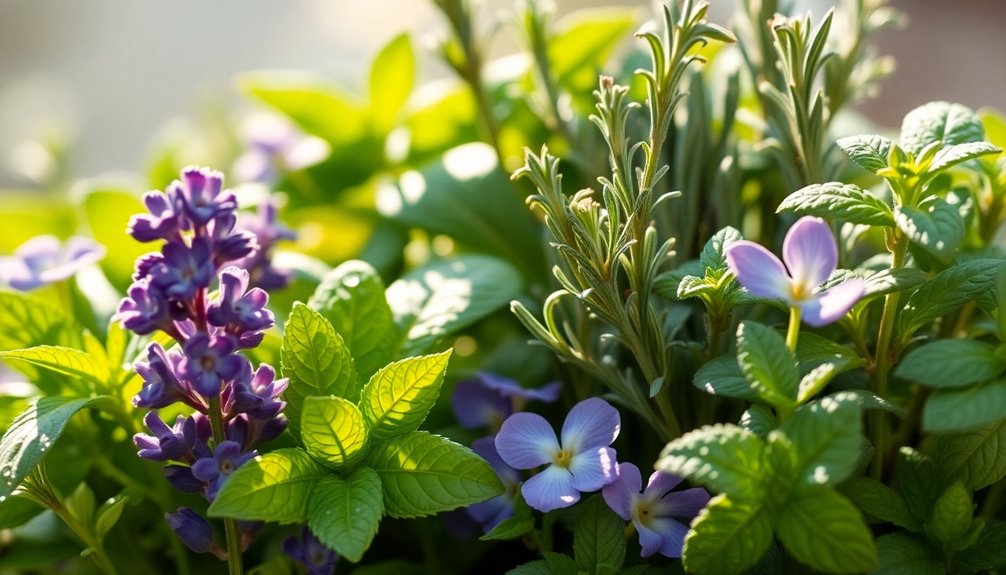
Aromatic plants offer incredible therapeutic benefits that can enhance your well-being.
You can explore stress reduction techniques through the calming scents of essential oils and discover herbal remedies that tackle common issues like digestive discomfort.
Stress Reduction Techniques
Stress can feel overwhelming, but incorporating aromatic plants into your routine can provide effective relief.
These plants offer various stress relief techniques that can help you find calm in your daily life. Consider the following:
- The soothing scent of lavender, known for its calming effects. Lavender oil is widely recognized for its ability to reduce stress levels and promote sleep, while relaxation techniques can further enhance this calming experience. Additionally, using essential oils safely is crucial to avoid any adverse reactions during your aromatherapy practice.
- Invigorating rosemary, which enhances memory and mental clarity.
- Relaxing herbal teas, like chamomile and lemon balm, that promote tranquility.
- Essential oils that trigger relaxation responses in your body, including aromatic cleaning that reduces reliance on harsh chemicals.
- Aromatherapy practices linked to lower cortisol levels, aiding emotional balance. Additionally, using essential oils for aromatherapy can enhance the overall benefits of these plants.
Aromatic Oils Benefits
Incorporating aromatic oils into your wellness routine can amplify the benefits you gain from aromatic plants. These oils, like lavender and rosemary, provide therapeutic effects such as stress reduction and anxiety relief. Additionally, their antimicrobial properties make them valuable in various medicinal products, including natural cleaners and skincare formulations.
| Benefit | Aromatic Oils |
|---|---|
| Stress Reduction | Lavender, Rosemary |
| Respiratory Relief | Eucalyptus, Peppermint |
| Immune Support | Tea Tree, Frankincense |
Herbal Remedies Overview
Herbal remedies have been used for centuries, offering a natural approach to health and wellness. Aromatic herbs, known for their essential oils, provide numerous therapeutic benefits, making them a staple in traditional medicine.
- Lavender's soothing aroma calms anxiety.
- Peppermint aids in digestion and relieves headaches.
- Chamomile promotes relaxation and better sleep.
- Rosemary enhances memory and cognitive function.
- Thyme acts as a natural antiseptic. Additionally, many herbal teas, such as green tea, are recognized for their rich antioxidant content, contributing to overall health. Regular consumption of anti-aging drinks can also support skin vitality and enhance overall well-being. Furthermore, certain herbs' antioxidant content can help combat oxidative stress, similar to the benefits of honey varieties like buckwheat honey. Hogwarts Greenhouses showcase a variety of magical plants, highlighting the rich diversity found in aromatic herbs.
Studies support these benefits, with the World Health Organization noting that many modern drugs derive from plant sources. Additionally, certain herbs like turmeric for pain relief have gained recognition for their effectiveness in managing chronic pain conditions.
In developing countries, around 60-80% of people rely on herbal remedies for primary healthcare, showcasing the importance of aromatic plants in global health practices.
Embracing these natural solutions can enhance your well-being.
Gardening Tips

When you're planning your garden, consider adding aromatic plants like lavender, rosemary, and sage not only for their delightful scents but also for their pest-repelling qualities.
Make sure you provide the right soil and sunlight conditions; for instance, mint loves shady spots, while thyme and rosemary thrive in sunny, dry areas.
Use companion planting techniques by pairing these aromatic herbs with your vegetables, enhancing flavor and naturally protecting your crops from pests.
Regularly prune your aromatic plants to maintain their shape and encourage new growth, boosting their fragrance and visual appeal.
When it's time to harvest, do it in the morning when essential oil concentrations are highest, and freeze any leftovers to preserve their flavor for later use.
Environmental Impact

Aromatic plants greatly impact the environment, as they attract essential pollinators like bees and butterflies, which support plant reproduction and biodiversity.
By incorporating these plants into your garden or community, you contribute to a healthier ecosystem.
Consider the following benefits of aromatic plants:
- Vibrant blooms that draw in hummingbirds and butterflies
- Natural pest-repellent properties, reducing chemical pesticide use
- Deep root systems that stabilize soil and prevent erosion
- Drought-resistant varieties perfect for low-water gardens
- Enhanced air quality through increased green spaces
These environmental impacts highlight the importance of aromatic plants in promoting sustainability and fostering rich biodiversity.
Embracing aromatic plants can lead to a healthier environment, benefiting both flora and fauna.
Aromatic Plants in Culture
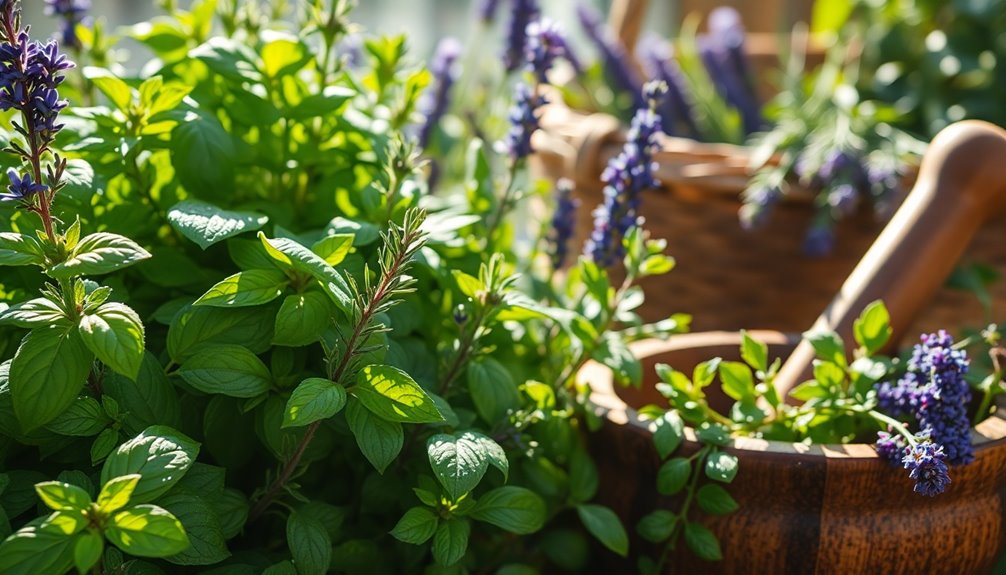
Throughout history, cultures around the world have embraced aromatic plants for their diverse uses and significance.
You'll find that plants like lavender and rosemary have long been valued for their soothing properties, often appearing in traditional medicine and rituals.
In the culinary domain, aromatic herbs such as basil, mint, and thyme elevate Mediterranean dishes, enhancing flavor profiles like no other.
The fragrance of aromatic flowers, including jasmine and roses, symbolizes love and beauty, making them central to many cultural celebrations and ceremonies.
Additionally, aromatic plants contribute to the perfumery and cosmetics industries, with essential oils from sandalwood and patchouli creating luxurious fragrances.
Today, the popularity of aromatic plants in aromatherapy highlights their therapeutic benefits for mental well-being and relaxation.
Future Trends in Aromatics
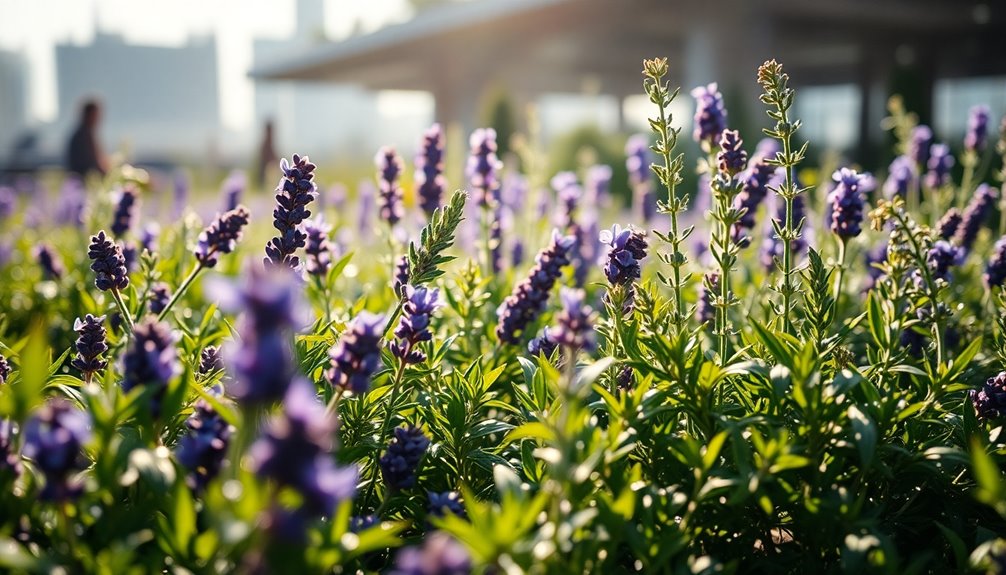
As interest in holistic health grows, the future of aromatics looks promising, with aromatic plants poised to play a significant role in various industries.
You'll see a surge in demand for essential oils due to their therapeutic benefits and antimicrobial properties. The rise of eco-conscious consumerism also drives preference for natural products, further boosting the market.
You can expect to witness:
- Innovative herbal supplements
- Enhanced formulations in cosmetics
- Increased research in modern medicine
- Sustainable farming practices
- Educational initiatives on aromatics
With the herbal products market growing at 6.8% annually, aromatic plants will certainly become integral to health and wellness, reshaping how you perceive natural remedies and their applications in everyday life.
Frequently Asked Questions
What Is an Aromatic Plant?
An aromatic plant's a type of plant that releases strong scents, often through essential oils.
You can find these scents in various environments, as they serve multiple purposes, like attracting pollinators or deterring pests.
When you encounter aromatic plants, such as mint or lavender, you might notice their distinctive fragrances that enhance your sensory experience.
These plants play an essential role in cooking, perfumery, and aromatherapy, enriching your daily life with their delightful aromas.
What Are Examples of Aromatic Plants?
When you think of nature's fragrant treasures, several delightful examples come to mind.
You've got rosemary, which adds a delightful essence to your culinary creations.
Lavender's calming scent can soothe your senses, while sage brings a unique earthiness to your dishes.
Then there's mint, revitalizing and invigorating, perfect for teas or desserts.
Finally, basil enchants with its sweet and peppery aroma, making it a cherished companion in Mediterranean cooking.
Enjoy exploring these aromatic wonders!
What Is the Difference Between Aromatic Plants and Medicinal Plants?
Aromatic plants focus on their fragrant properties, often used to enhance sensory experiences in perfumes or cooking.
You'll find that their essential oils are released when you crush or touch them.
In contrast, medicinal plants offer therapeutic benefits and require specific preparations for health use.
While some aromatic plants also have healing qualities, the primary distinction lies in the purpose: one is for scent, and the other is for health.
What Are 5 Aromatic Plants With Botanical Names?
If you're looking for aromatic plants, consider these five:
Lavandula angustifolia 'Sharon Roberts' offers a delightful fragrance and attracts pollinators, while Rosmarinus officinalis 'Santa Fe Dark Blue' adds culinary flair with its aromatic leaves.
Agastache rupestris brings a unique licorice-mint scent, and Calamintha nepatoides 'White Cloud' contributes a strong mint aroma.
Finally, Teucrium aroanum, with its honey-like scent, enhances any garden and supports pollinators beautifully.
Conclusion
To sum up, aromatic plants are like nature's perfume, enriching our lives with their delightful scents and flavors. Whether you're cooking up a storm, exploring their therapeutic benefits, or simply enjoying their beauty in your garden, these plants offer endless possibilities. As you cultivate your connection with aromatics, you're not just nurturing your surroundings but also fostering a deeper appreciation for the environment and culture. Embrace these fragrant wonders and let them inspire your everyday life!

